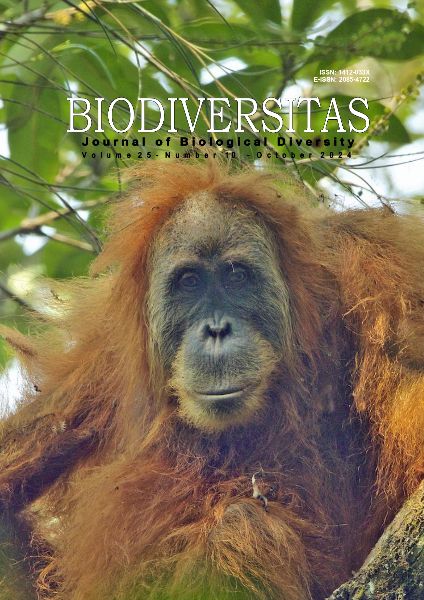Phytochemicals’ compound and antioxidant activities in the food of Pongo tapanuliensis from Batang Toru Forest, North Sumatra, Indonesia
##plugins.themes.bootstrap3.article.main##
Abstract
Abstract. Sianipar HF, Widoretno W, Hakim L, Amolia RR, Fatchiyah F. 2024. Phytochemicals’ compound and antioxidant activities in the food of Pongo tapanuliensis from Batang Toru Forest, North Sumatra, Indonesia. Biodiversitas 25: 3454-3463. Campnosperma auriculatum (Blume) Hook.fil. and Agathis borneensis Warb. are food for Pongo tapanuliensis Nurcahyo, Meijaard, Nowak, Fredriksson & Groves, 2017 found in the Batang Toru Forest, Indonesia. Studying the phytochemical properties of both plant species is important part of conservation framework for Tapanuli orangutans because information regarding their nutrient contents and benefits still needs to be investigated. This research examined the closest components, amino acids, and phytochemicals compounds that have antioxidant activity. The C. auriculatum and A. borneensis fruit were tested for proximate, amino acid, phytochemical, total flavonoid content, LC-MS/MS, and FRAP to determine antioxidant activity. The results of proximate and amino acid tests showed that C. auriculatum has higher contents of carbohydrates (74.49%), protein (7.54%), lipids (3.73%), energy from fat (33.57Kcal/100 g), total energy (361.71Kcal /100g), L-Histidine (1704.975ppm), L-Leucine (3759.28ppm), and L-Lysine (2099.038ppm) compared to A. borneensis. The phytochemical tests of both samples were positive for containing alkaloids, flavonoids, saponins, steroids, tannins, phenolics, and quinolines. The higher flavonoid content is found in C. auriculatum (94.44±2.77mg QE/g). LC-MS/MS results for both samples, C. auriculatum that is (3alpha,20R,24Z)-3-Hydroxy-21-oxoeupha-8,24-dien-26-oic acid, terpenoid group, and A. borneensis, that is Procyanidin B2, the flavonoid group. The higher antioxidant capacity was found in C. auriculatum (4.63±0.111µg/mL). The C. auriculatum has excellent potential as a natural source of nutrition and antioxidants for the Tapanuli orangutan; therefore, it is necessary to develop a strategy by cultivating these two plants and using them in pharmacognosy for P. tapanuliensis.


 http://orcid.org/0009-0009-5297-5890
http://orcid.org/0009-0009-5297-5890